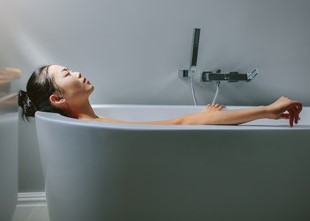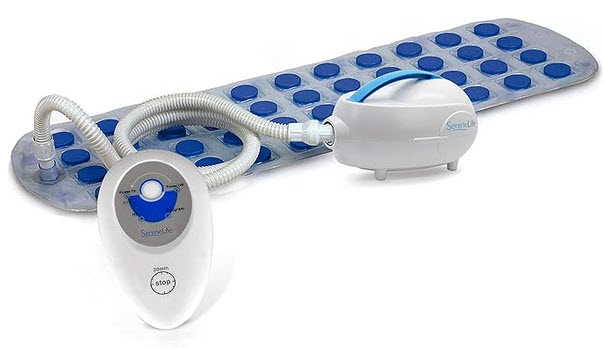Fibromyalgia Basics
Spa Therapy at Home

Today a “trip to the spa” makes up a multi-million-dollar industry that claims to relieve pain through massage, seaweed wraps, and mud baths—which are the focus of numerous clinical studies for fibromyalgia. Cleopatra, the “woman who time could not wither,” often frequented the Dead Sea around 40 BC to reap the benefits of the hot, mineral rich water. Even today, people line up to redeem these services, which begs the question: Is this how fibromyalgia used to be treated before modern medicine?
Balneotherapy, a term for bath therapy, was tested in seven different studies to determine if the treatment could truly help fibromyalgia patients find symptom relief. The trials used 20 minutes of various types of hot bath therapies five days a week for two to three weeks, often combined with a relaxing environment. All seven experiments showed significant improvement in fibromyalgia symptoms, even three to six months after the therapy ended.1 No drug works this well, so why is moist heat so beneficial?
How it Works
Patients in most studies did not use simple hot bath water. The minerals found in the spa water are high in magnesium, sulfur, and potassium. However, it appears the addition of these salts may be optional because the evidence for heat (hot water or mud) is overwhelming.
Hot water produces analgesia (pain relief) by targeting the heat sensors in the skin to raise your threshold for pain. As you have probably experienced, warm water soothes sore muscles by helping them relax and reduces spasms. This heat is also known to ease the pain of myofascial trigger points. These are knots in the muscles that can often be felt (they are firm), and the more you move the muscle the more these trigger points make you hurt.2 Here is where the buoyancy of water also helps reduce the pressure on sore muscles.
Help with Hormones
Heat stimulates the release of cortisol, which works as a pain-relieving anti-inflammatory. It could also offer an added benefit, as cortisol is low in most people with fibromyalgia.3 The warmth also promotes the release of growth hormone to help repair worn out tissues, another hormone that is low in fibromyalgia patients.4 In addition, heat in various forms, including sauna and mud packs, increases your body’s natural pain-relieving beta-endorphins.
“This increase in beta-endorphin explains the analgesic and anti-spastic (reduced stiffness) effect of spa therapy,” says lead author Giacomo Guidelli, M.D., whose report explains the potential benefits of bath therapy.1
Reduced Stiffness
Most anyone getting out of a whirlpool feels more limber, but how do you know whether it is the heat or the jet-like hydrotherapy that reduces your stiffness? A Turkish team looked into this matter by measuring lung function in fibromyalgia patients before one of the two therapies (heat or hydro), three weeks after the therapy, and six months later.5
Both therapies helped to loosen up the muscles surrounding the lungs to make breathing easier, but only the patients in the hot tub group were able to demonstrate objective benefits lasting until the six-month follow-up. Patients in the hydrotherapy group (lukewarm water with the jets) only showed improvements short-term, so it is the heat and not the jets, that relieves the stiffness.
Chilling Out Pain
The nerves traveling through your muscles have sensors to detect when certain chemicals get too high (a sign your muscles have overdone it). In turn, these sensors send off an alarm to your brain, saying your muscles hurt and your brain needs to tell them to stop working. It’s a way to help prevent muscle damage.
One particular sensor is well-known for detecting the burning pain produced by a chemical in chili peppers. And when these sensors are triggered, they tell your brain your muscles are experiencing serious pain.
The muscle nerves in people with fibromyalgia appear to contain way too many “chili pepper” type of sensors.6 This can make your muscles hurt even if they have not been overworked. However, one way to “chill” them out is to submerse your muscles into soothing heat on a regular basis, which leads to a reduction in pain sensors. Moist heat penetrates deep into the tissues and should get these sensors to back down, reducing achy muscles even when you are not in the tub.
Immune Function
A link between the thermal effects of the heated water used in balneotherapy and the immune system is also documented. In several studies, it has been found that the therapy can influence the mediators of the inflammation response. Perhaps an immune-suppressive effect?
Hot water at about 100 to 104°F suppresses the production of pain-promoting chemicals (such as IL-1 and IL-6), as well as substances involved in causing inflammation.6 Inflammatory mediators located in the body’s soft tissues might play a key role in producing the symptoms of fibromyalgia, says Fusun Ardic, M.D., a researcher in this field. Without these key regulators of inflammation, heat can be an effective way to stop muscle swelling, stiffness, and fibromyalgia pain.
Oxidizing Effects
The mineral effects are less understood. The skin absorbs chemicals in the water almost immediately. So minerals are primarily thought to work as antioxidants by drawing out chemical waste products from the tissues. A buildup of oxidative chemicals in the tissues is frequently described in fibromyalgia patients. Also, magnesium, an inflammation-reducing mineral, appears to be low.
Fast Acting, Long Lasting?

Regardless of the short-term change of scenery or resort-like environment, studies of bath therapies show long-lasting effects in people with fibromyalgia. All the reports mentioned above showed two to three weeks of balneotherapy reduced fibromyalgia symptoms for up to six months compared to other treatment methods.
While heat and mineral water therapies can’t replace your conventional drug treatments altogether, adding a hot bath offers additional benefits. And better yet, none of the patients in the studies showed evidence of any side effects (of course, the subjects only had fibromyalgia and other conditions might not do as well). Either way, the benefits of this nondrug therapy could be a way for you to relax and provide you with much-needed pain relief.
Although regular visits to the Dead Sea for its soothing hot mineral water is not as feasible for you as it was for Cleopatra, a bathtub or hot tub may help keep you functional and halt your symptoms from winning the battle.
Do It Yourself Approaches
Here are some ways for you to duplicate the spa effect at home without paying the hefty prices:
Saltwater Spa Bath: Add 1/3 to 1/2 cup of salt (Sea Salt, Dead Sea Salt, Epsom) to water at about 99-104°F. Some hot water heaters are set to not go this hot, however, there are ways to adjust it. Be sure to use a thermometer to make sure you don’t overdo it. Try to soak 20-30 minutes daily. Try to use fine or medium grain salts that will dissolve completely in water and are not highly mineralized so as not to clog the jets (if you use a jet spa gadget).

Tub Gadgets: One option for keeping the water warm is a four-foot long “massage mat” that produces heated air bubbles to simulate a back massage; SereneLife is around $140 (see photo). There are other brands but be sure you purchase one that specifically heats the air (bubbles alone will cool down the water). For safety reasons, steer clear of submersible gadgets that directly plug into an electrical outlet. Pillows, diffusers for essential oils (if certain scents relax you), and other gadgets can help you transform your bathtub into a spa-like experience.
Hot Tubs: An easy way to reach optimum temperature for pain reduction, it might not be as costly as you think. Jets are not as important as the temperature. Look for models with fewer jets (the more jets, the greater the cost). Also consider last year’s model (unused and often in the back room) that retailers are eager to unload at a discount. Another option might be a used hot tub from a local company that refurbishes them (but make sure you get at least a one-year warranty). Keep in mind that the larger the hot tub, the more expensive it will cost to run. However, if you save a doctor’s prescription along with your medical records, it might be used as a tax write-off under medical expenses.
Long Hot Showers: Sit on a stool in the warm stream of your shower head. Just make sure you select a time when your water heater has an ample supply of hot water.
Heating Pads: Most heating pads have a moist heat option that can be used to cover surface areas such as the whole back under safety settings.
1. Guidelli G, et al. Clin Med Insights: Arthritis Musculoskelet Disord 5(2):19-26, 2012.
2. Ge HY, et al. Eur J Pain 16:196-203, 2012.
3. Riva R, et al. Int J Behav Med 17:223-33, 2010.
4. Bennett RM, et al. Am J Med 104:227-31, 1998.
5. Kesiktas N, et al. J Back Musculoskel Rehabil 24:57-65, 2011.
6. Light AR, et al. J Intern Med 271:64-81, 2012.
7. Ardic F, et al. Rheumatol Int 27:441-6. Oct. 11, 2006.
